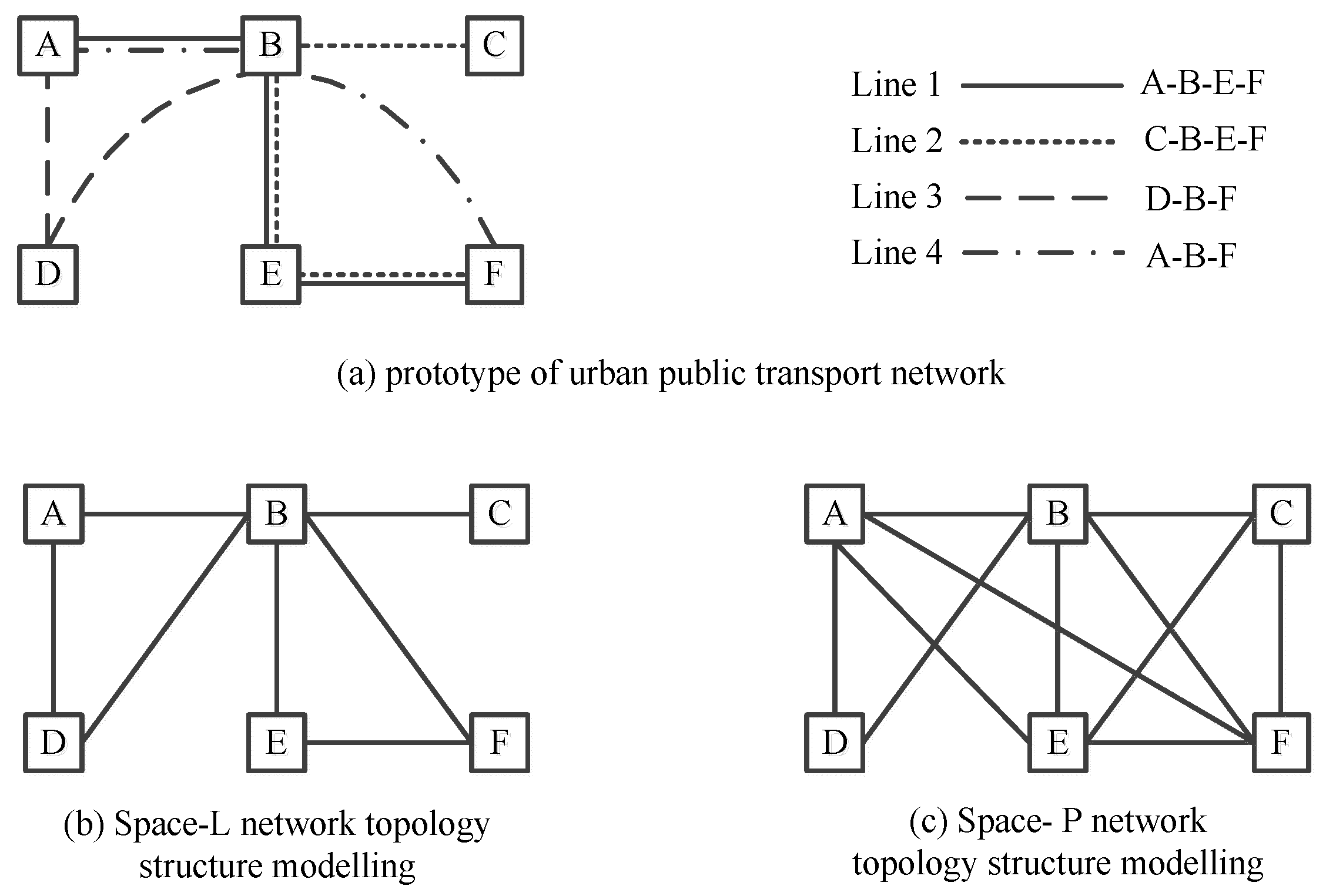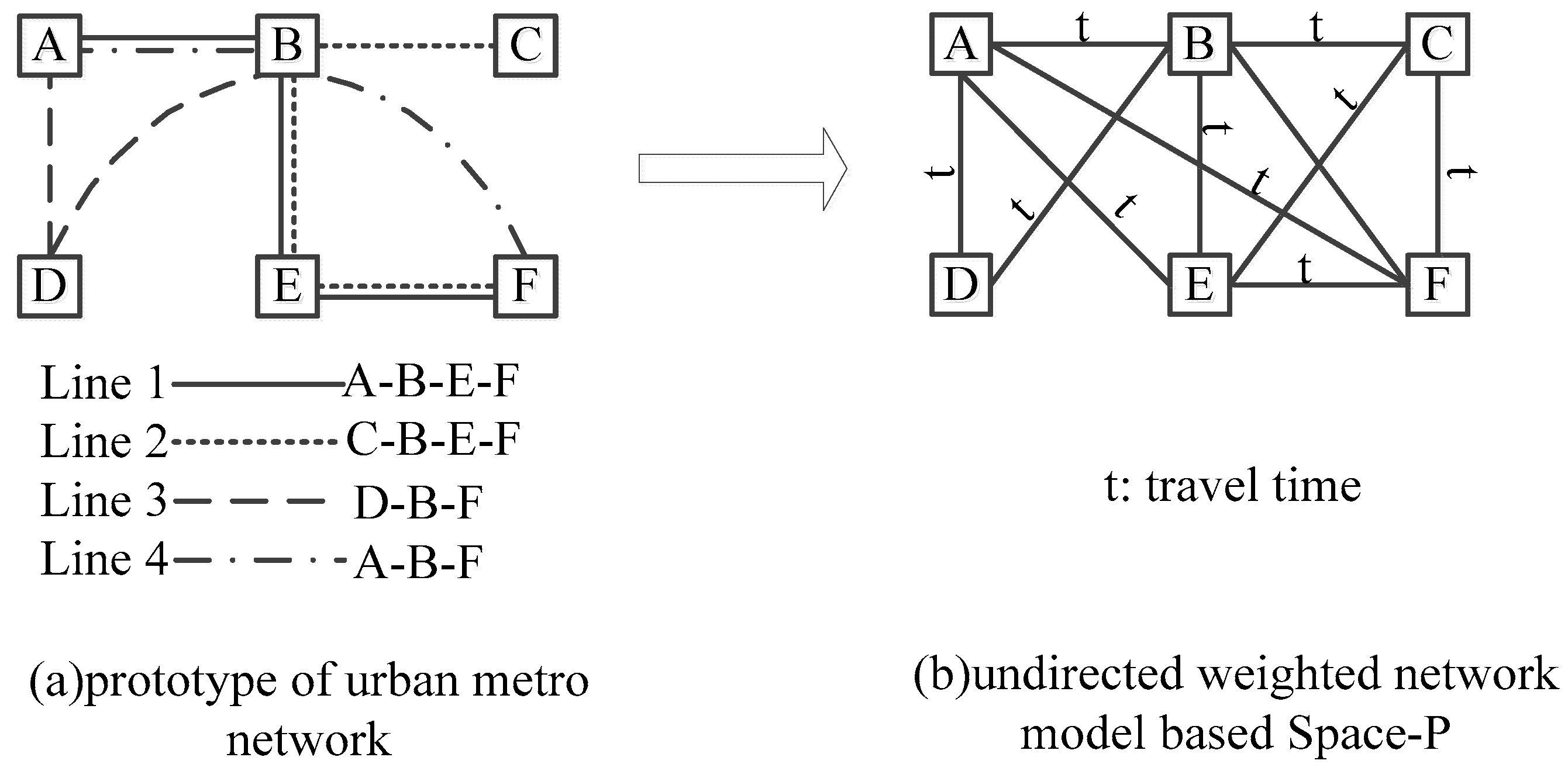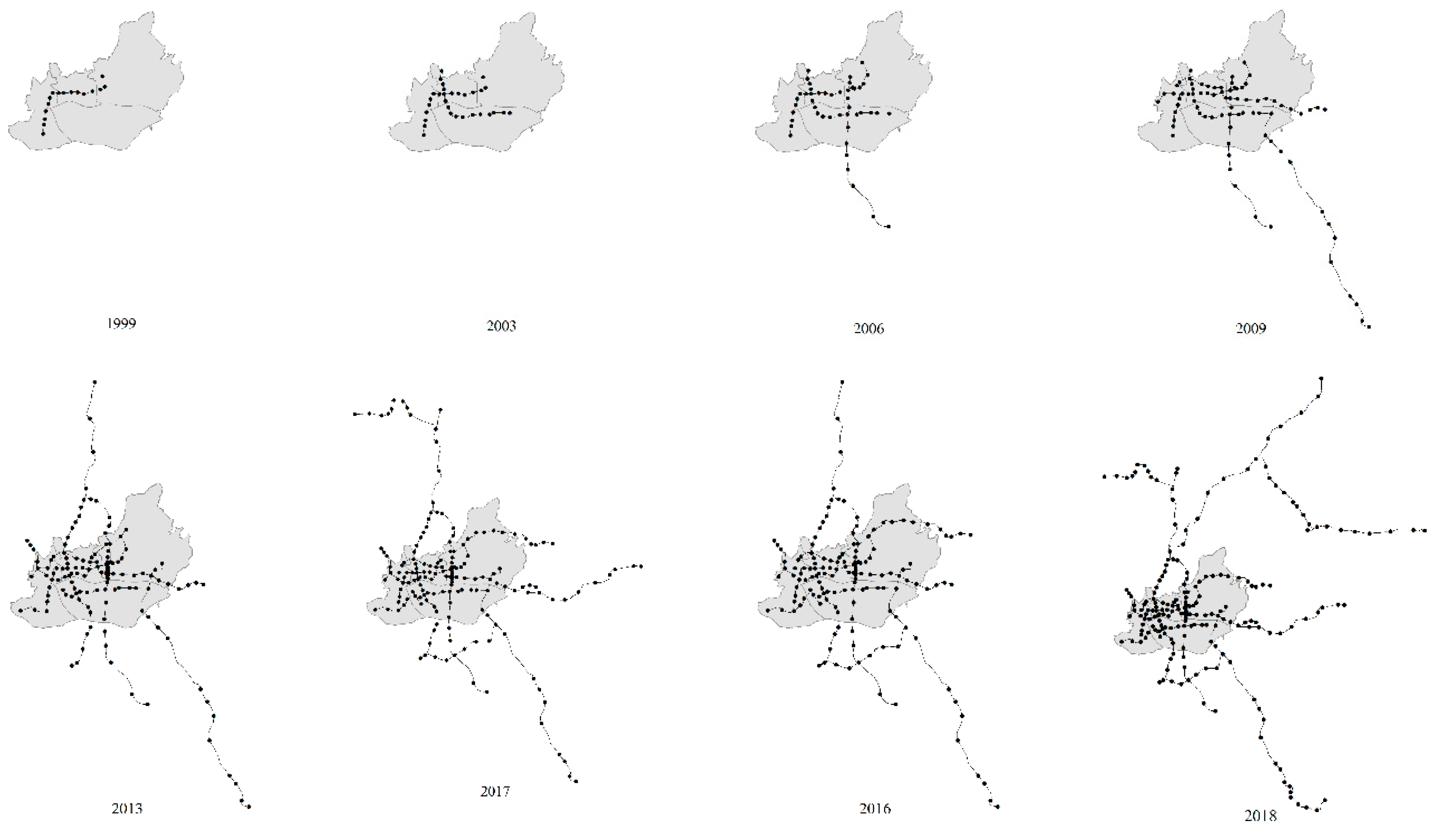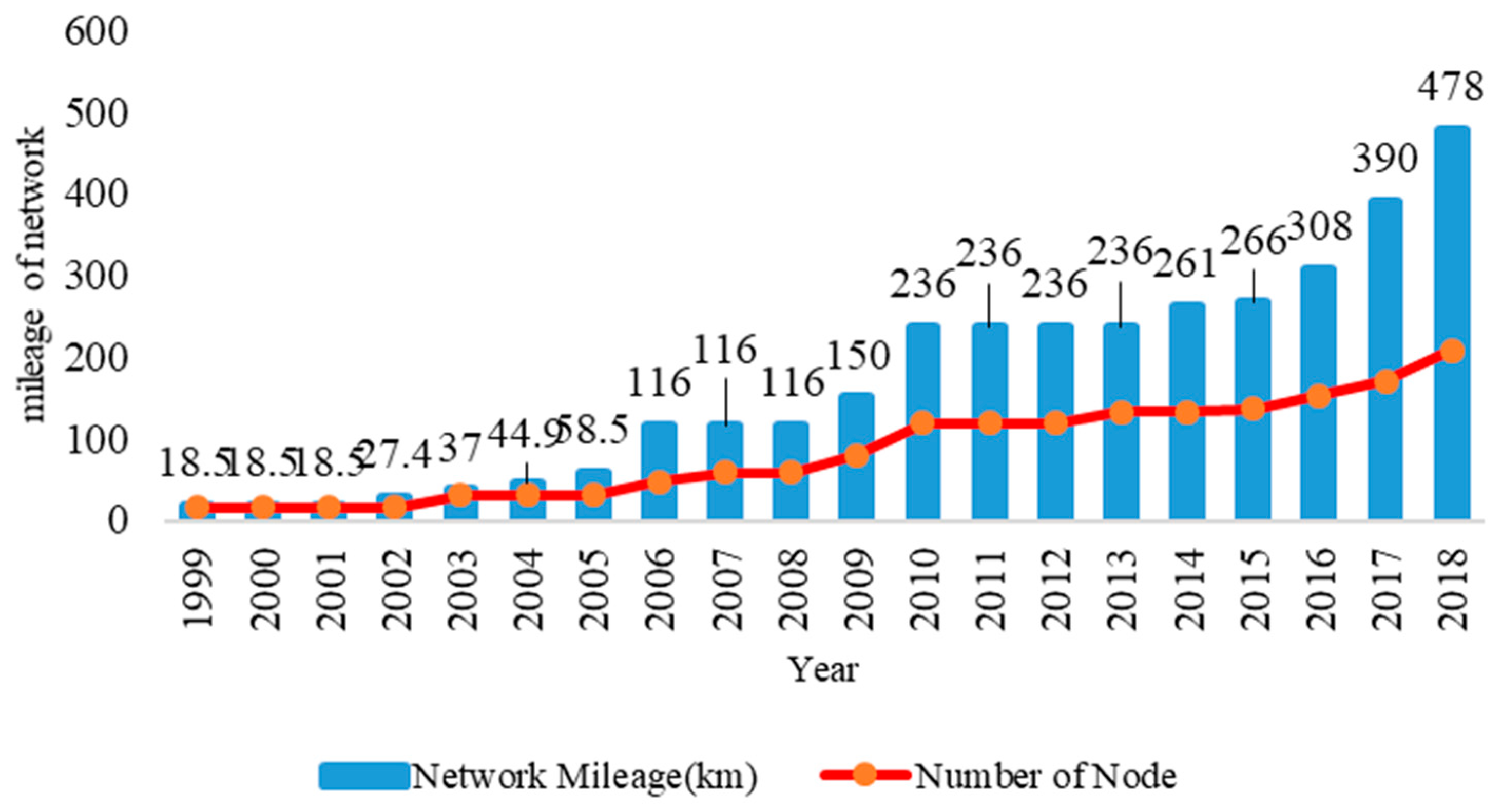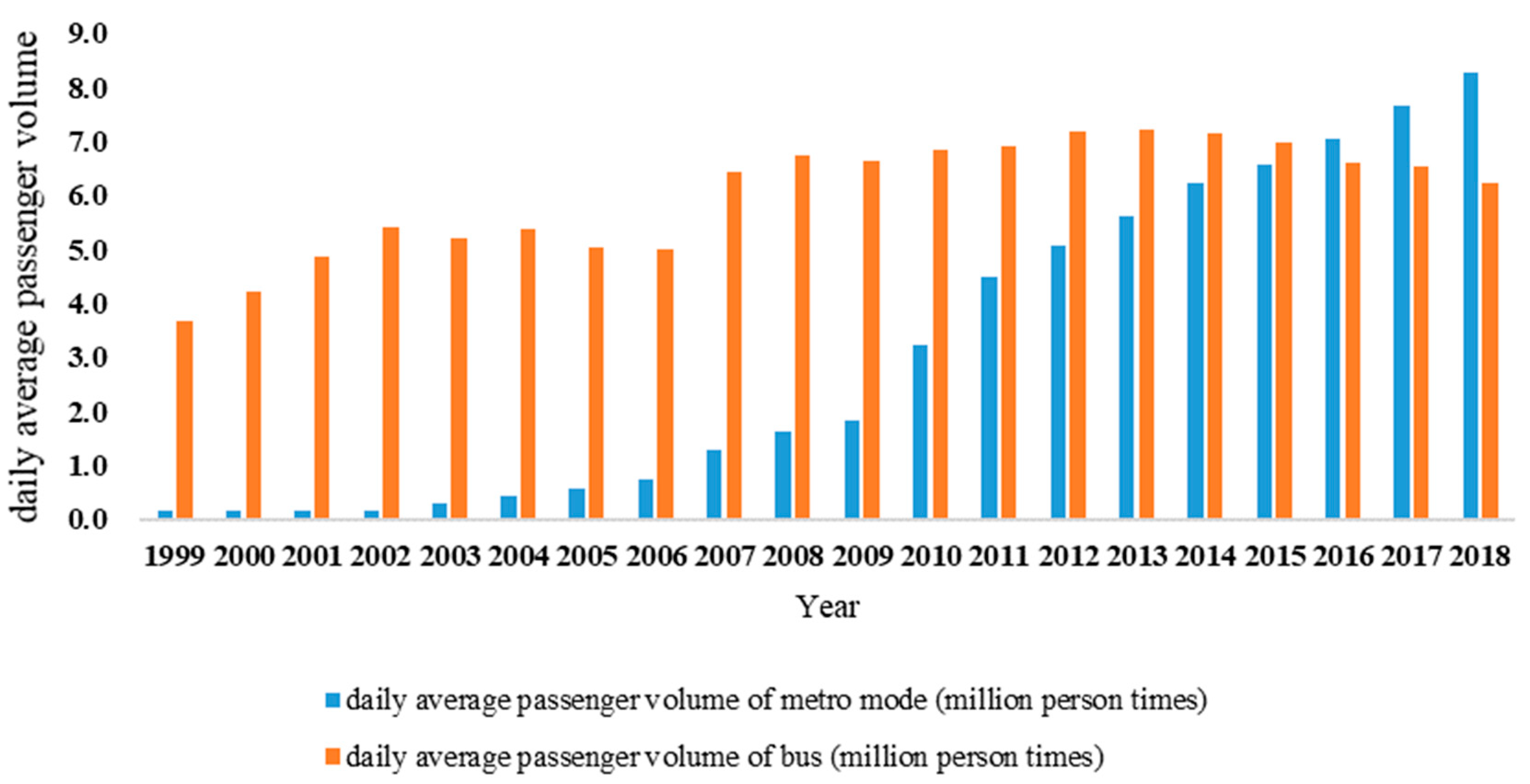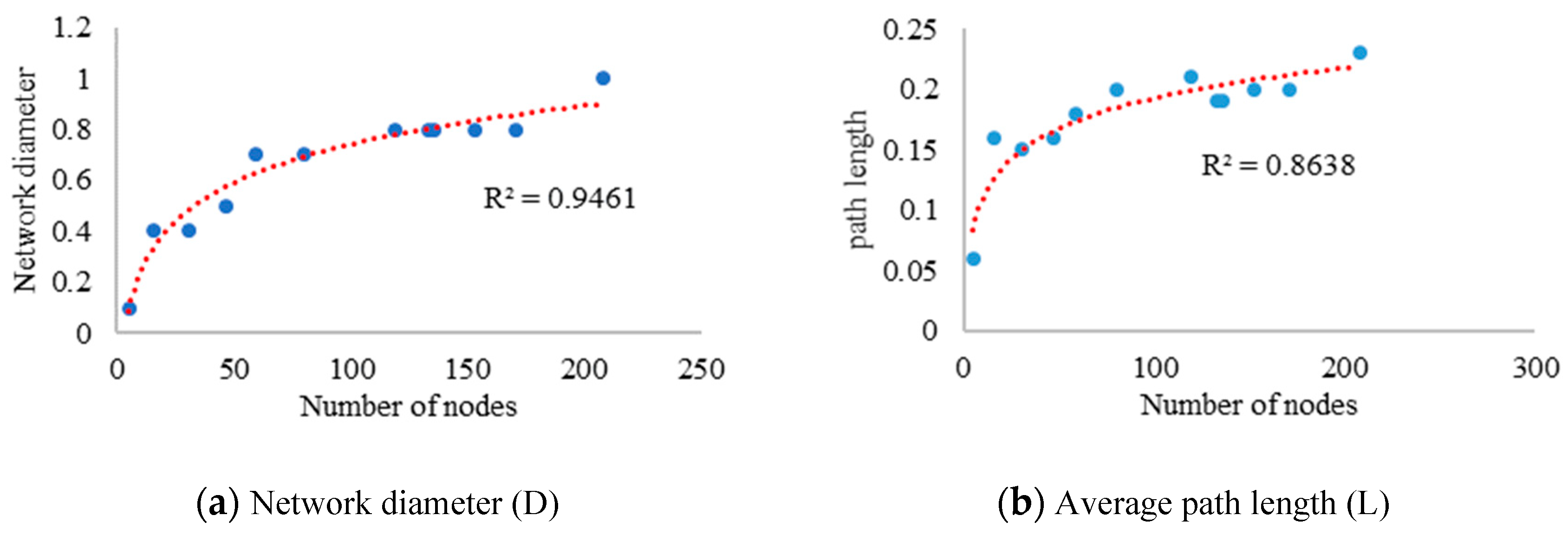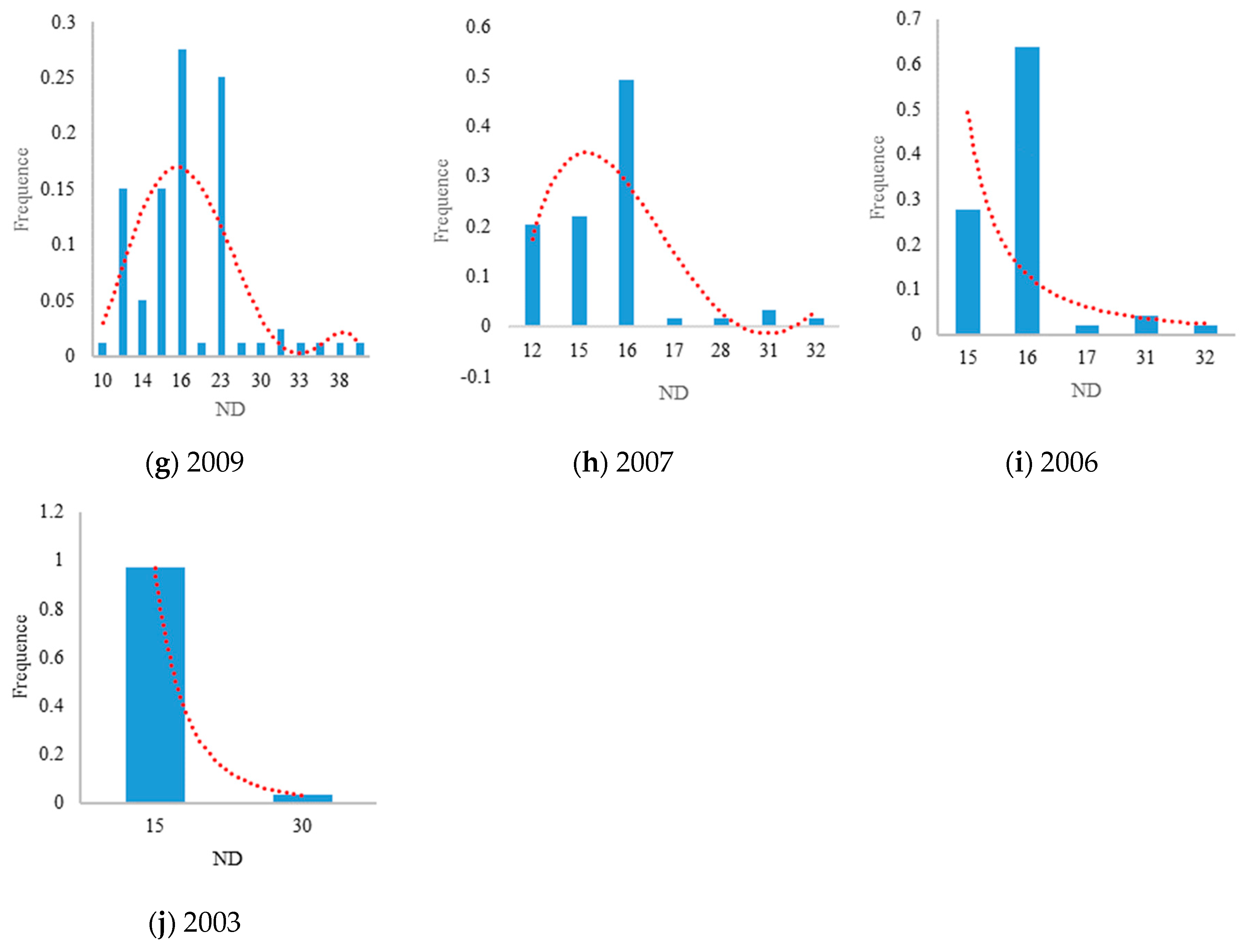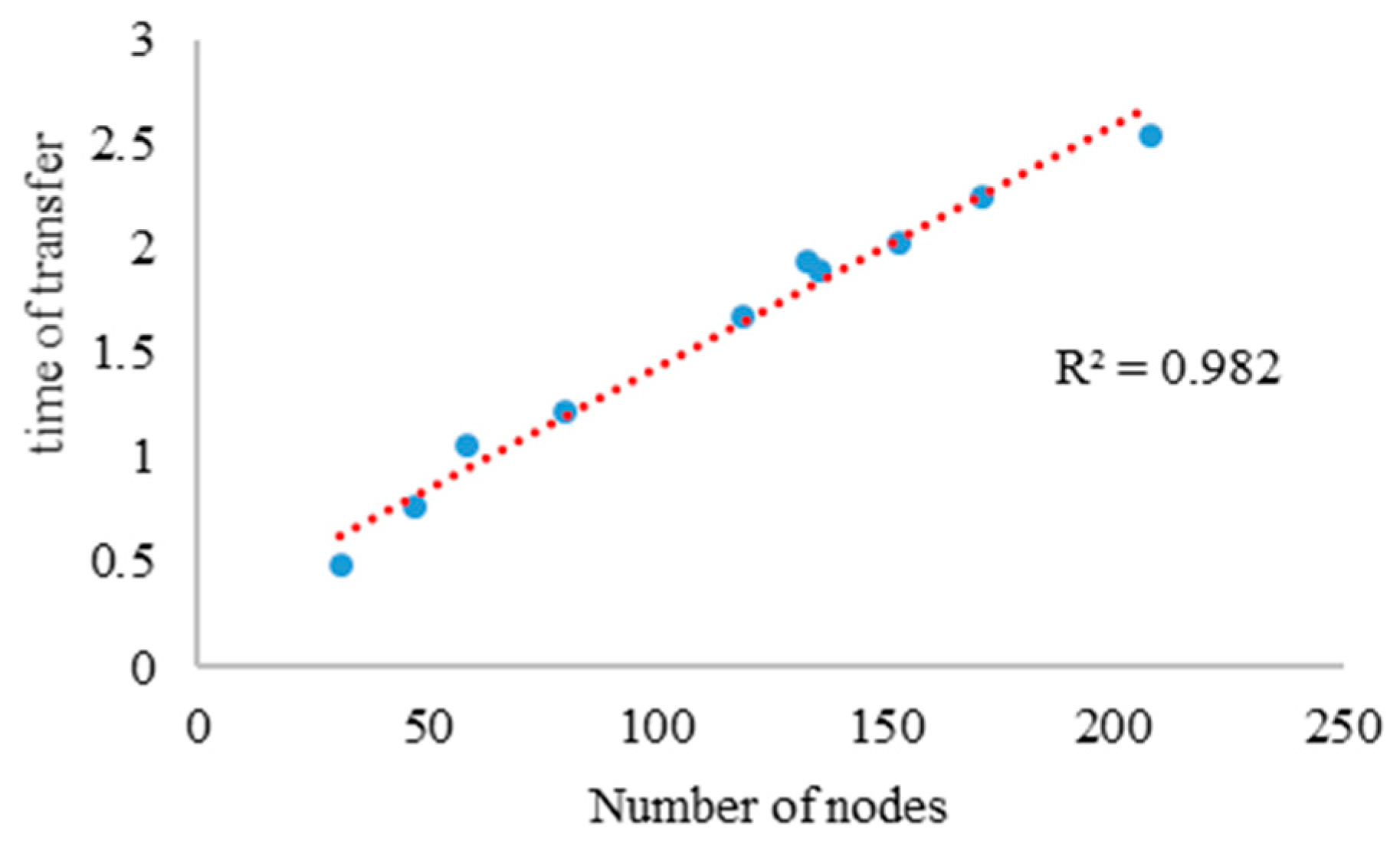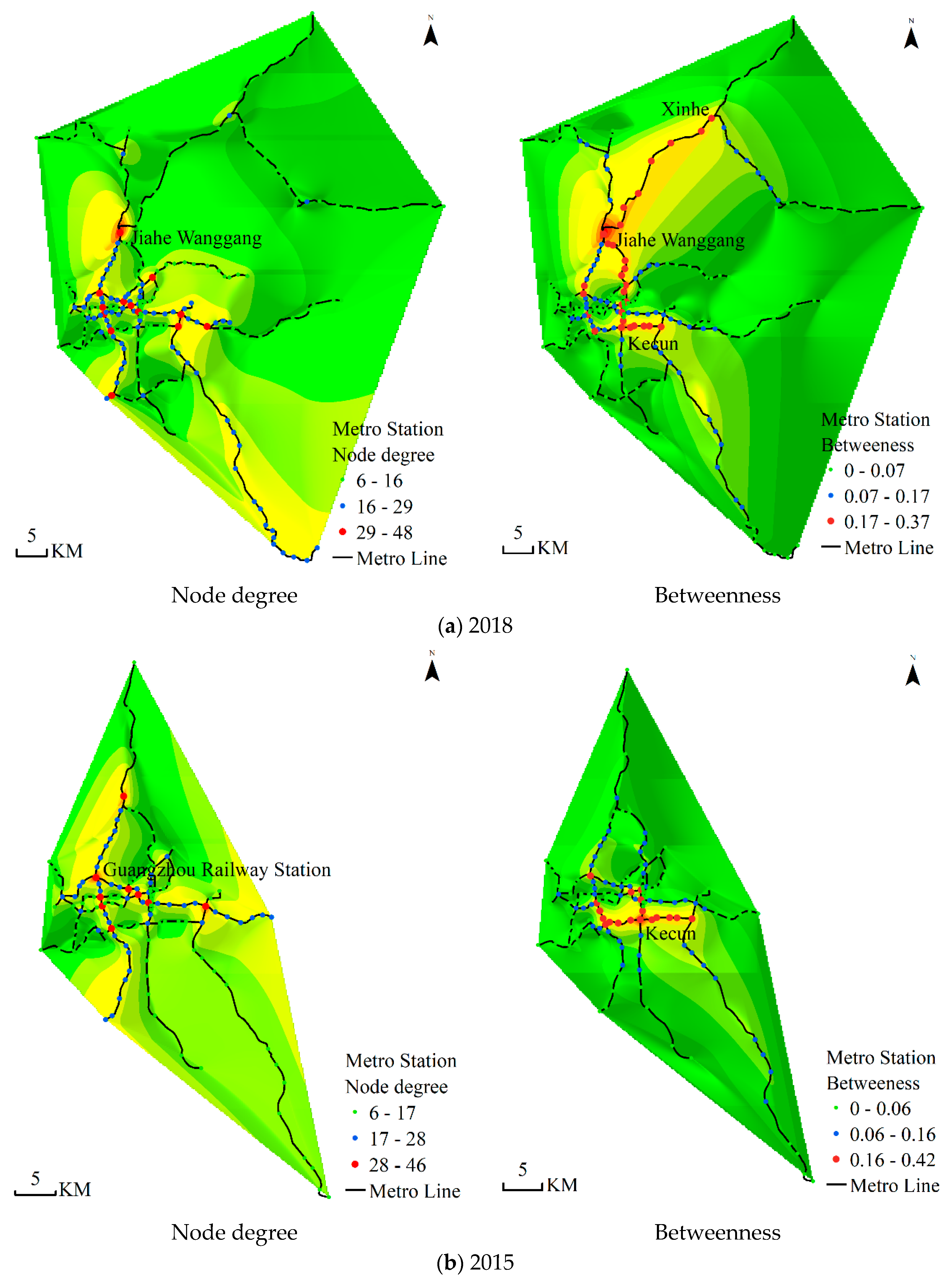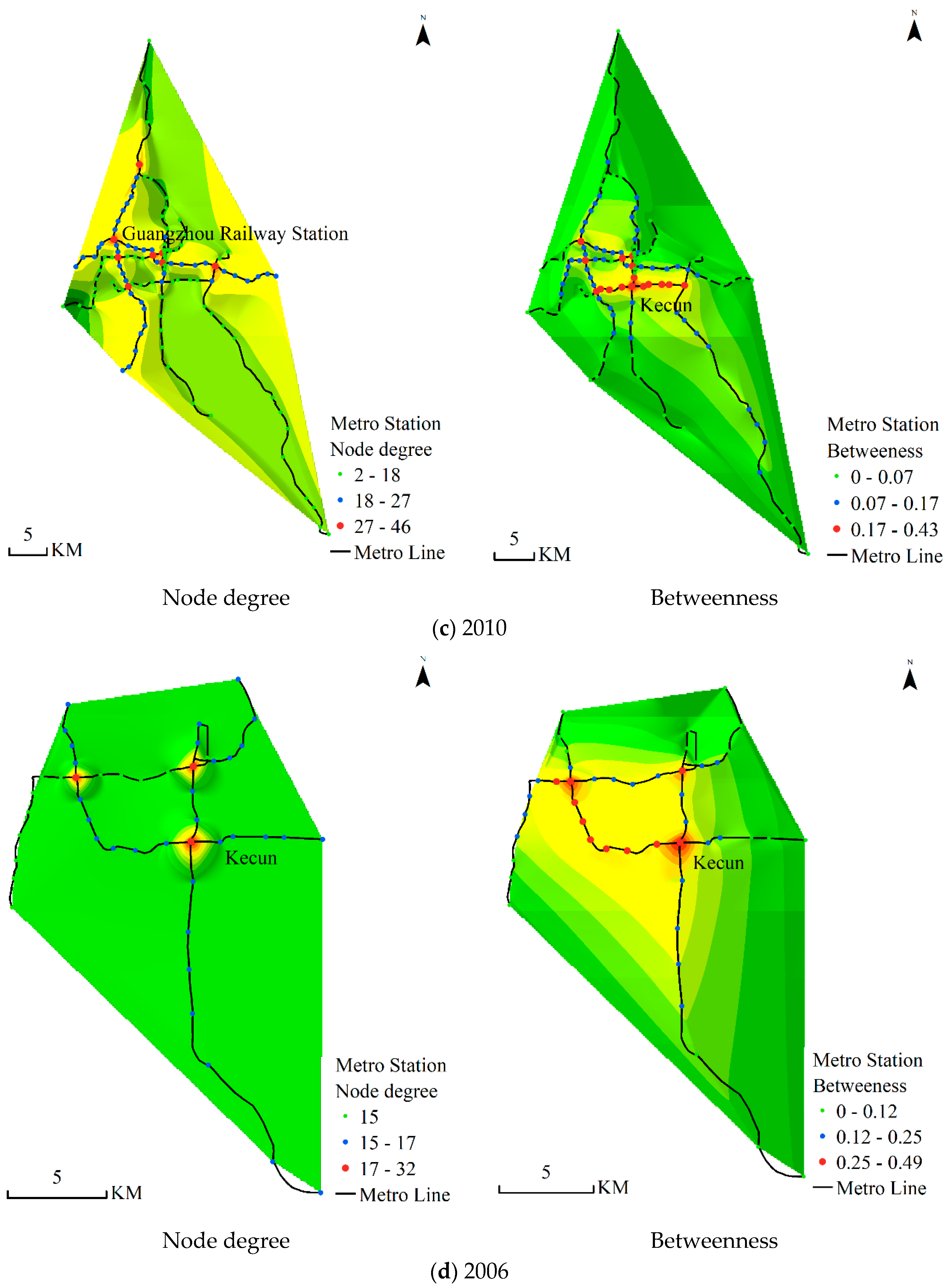1. Introduction
With the development of modern transportation technology, the emerging countries and their major cities all over the world are seeking a well-developed urban rail transit network system to alleviate the increasingly serious traffic problems, especially to optimize land use spatial structure and transport accessibility in the urban system [
1,
2,
3]. In China, for example, since the city of Beijing became the first city to have a metro line in 1969, there are now 35 metropolises with a metro network with a total mileage of nearly 4600 km. Among them, the top three metropolises with the largest metro network mileage are Shanghai, Beijing, and Guangzhou. Since 1997, the Guangzhou Metro Network (GMN) has been developing rapidly, while the economy of the city has been booming continuously. Currently, the metro network system in Guangzhou is composed of 16 lines (service routes) and 218 stations. As an important part of the modern public transport service system, the urban metro network has many advantages, such as large traffic volume, high speed, long distance, less pollution, and intensive land use, compared with the conventional public transport modes, such as bus and tram. Certainly, achieving a reliable metro network structure and reasonable spatial network distribution pattern should play a significant role in improving the quality of urban public transport services and promoting the urban sustainable development, especially in a developing country context [
4].
With the development of network science theory in the field of transport study, the complex network theory has become an important tool for modeling and characterizing the transport network topology. In the context of complex network theory [
5,
6], more and more scholars build transport network models based on Space-L and Space-P by using the entities (such as stops) of a complex network system and the interaction or association between the entities (such as service routes). Moreover, the graph theory and statistical physics are applied to explore the statistical law of the geometric and topological property in a transport network [
7,
8,
9,
10], with an important aim of providing the scientific references and decision-making support to the transport network planning. At present, the complex network theory has evolved into a new and extensive scientific paradigm of network system analysis and design. Many studies have focused on the analysis of the complexity, characteristics, and topological properties of urban rail transit network, such as a metro network, mainly considering the following aspects: (1) Measuring and characterizing the statistical characteristics such as node degree distribution of an urban metro network, and verifying its “small world” or/and “scale-free” phenomenon [
11,
12,
13], (2) according to the geographical spatial characteristics of a given urban rail transit network, the powerful spatial analysis tools, such as geography information system (GIS), are integrated into the complex network analysis to evaluate the spatial network topological structure [
14,
15], (3) through measuring and quantifying the key topological parameters, such as degree centrality (DC), betweenness centrality (BC), and clustering coefficient (CC), the statistical characteristics of nodes in network are assessed thoroughly [
16,
17,
18,
19,
20,
21], (4) discussing the dynamic characteristics or the emergence behavior of the whole metro network while it is changing (such as being attacked), including vulnerability, reliability, robustness, etc. [
22,
23,
24,
25,
26,
27], furthermore, implementing the comparison between the urban metro network complexity characteristics in different cities, and then investigating the topology and classification of the given networks [
19,
21,
28,
29]. In summary, the existing research has carried out a more in-depth study of the topology and complexity characteristics of the transportation network. Especially, under the support of GIS, which is one of the innovative approaches that characterize the spatial correlation between spatial entities [
30,
31], the complex network analysis for the spatial topological characteristics of the transportation network shows a more extensive prospect.
However, the empirical analysis of the topology evolution of a given metro network in its complete growing period is less involved, making it difficult to recognize the characteristics and issues in each developmental stage during the growth of a network. In addition, as a typical real-life network, although the basic topological properties and characteristics of an urban metro network can be intuitively revealed through the complex network analysis, in the absence of time, distance, time of transfer or other network service information, it is hard to learn clearly about the performance of network service, especially under a specific topological structure. Indeed, for urban planners, how to improve the service level and quality of a transport network is a crucial issue in urban planning.
Therefore, on the basis of the complex network theory, this paper introduces the time cost, time of transfer, and other information of the travel paths among metro stations, and then establishes origin–destination (OD) matrixes and weighted network models during the growth of the Guangzhou Metro Network. Based on the complexity analysis of GMN, furthermore, this paper focuses on evaluating and characterizing the evolution of the spatial network topology and related issues in different network development stages by integrating with GIS. This study would serve as the scientific basis and decision-making support for the planning and operation management of the Guangzhou Metro Network.
2. Methodology
2.1. Modeling of Urban Metro Network
In the context of the network science theory, the modeling of an urban public transport network (such as a metro network) is generally implemented by using the methods of Space-L and Space-P. In the network modeling based on Space-L, a station is identified as one node in a network, while there is at least one service route (i.e., a metro line) between two adjacent nodes, these two nodes should be connected with an edge. As a network modeling of Space-P, a station is also defined as one node in a network, if there is at least one direct route (without transfer) between any two nodes, there is an edge between them. As shown in
Figure 1, the actual shape of a public transport network is illustrated, and the corresponding network modeling based on Space-L and Space-P is also presented, respectively. Obviously, the Space-P network model is built on the service routes of a public transport network, and currently is widely applied to investigate the transportability between two nodes in a network. Therefore, compared with the Space-L model, the network structure modeling based on Space-P can more realistically reflect the service level and quality of an urban public transport network.
A large number of studies have illustrated that complex network analysis is an efficient and convenient way to understand the topology of a public transport network. Nevertheless, due to the lack of the locations (geographical characteristics) of stations, and particularly the impedance information, such as travel time or time of transfer between stations, the outcome derived from the analysis cannot identify the service level and quality of a public transport network under its specific topological structure. According to a questionnaire survey on the residents’ travel behavior by using metro mode in Guangzhou made by our research team in 2018, the residents in Guangzhou are most concerned with the convenience of travel by using metro mode, which specifically implies their psychological choice of less travel time and time of route change (i.e., transfer). It needs to be emphasized that the concerns of shorter time of transfer are also based on the priority choice of less travel time. From the residents’ perspective, 30 min (without transfer) to travel by metro is the most ideal time cost, and the acceptable time cost is 30 to 50 min (or/and one time of transfer), but more than 50 min or/and over two times of transfer are the most unacceptable choice. Therefore, in order to attain the time cost and time of transfer required to travel between two stations in GMN, the spatial data modeling and analysis tool of GIS, i.e., ArcGIS 10.2 is applied. In the environment of GIS, the shortest path algorithm of Dijkstra is used to analyze the shortest path of travel time, and the path’s time of transfer and length between any two nodes. Therefore, an origin–destination (OD) matrix can be accomplished on the basis of a given quantity of OD, such as travel time or time of transfer. If the total number of nodes is N in a network, it implies that there are N × N pairs of nodes. Therefore, the OD matrix (named time matrix) based on the minimum travel time of each pair of nodes can be built, and represented by:
In the OD matrix, t
ij is the time cost of the shortest travel path between nodes i and j, when i = j, t
ij = 0, that is, the travel time between nodes i and i is excluded. The time cost for waiting and transferring during the travel between nodes i and j is not included in t
ij, as it is difficult to be gotten. Moreover, the OD matrix (name as transfer matrix) based on the time of transfer of each pair of nodes can be attained and identified as:
r
ij is the times of transfer (route change) between nodes i and j, if i = j, r
ij = 0. In terms of the transfer matrix, the average time of transfer of all paths between any i * 0028 two nodes in the network can be calculated and represented as θ as follows.
NP is the total number of the paths among the nodes in network.
Furthermore, the ratio of the number of paths which need to transfer to the total number of all paths in the network can be attained, and described as δ.
ρ is the number of the paths with the time of transfer is more than 0.
In the Space-P network model, the edge between nodes i and j shows that there is at least one direct route (metro line) between two nodes. This implies that the time of transfer is 0 for each edge in the network. In this paper, however, through assigning the travel time to each edge and considering that the round-trip time is the same for each edge, an undirected weighted network model based on Space-P is constructed. As shown in
Figure 2, each metro station is defined by a node in GMN. GMN can be represented as v, v ∈ V and V is the vertex set. While two metro stations are connected by a metro line (without transfer), there is an edge between them, and represented as s, s ∈ S, S is the edge set. As a result, the Guangzhou Metro Network can be described as G = (v,s), and the total number of nodes and edges is represented as N and M, respectively.
2.2. Topology Measuring of the Overall Network
The indexes for evaluating the connectivity of the overall network include network diameter (T), average path length (L), network efficiency (E), connection rate (β), loop index (μ), actual loop forming rate (α), and actual combination degree (γ). Among these indexes, network diameter (T) is a key index to characterize the size of the network in space, while the average path length (L) reflects the spatial dispersion of nodes in the network. T and L can be calculated as follows:
t
ij is the time cost of the shortest travel path between nodes i and j, where the maximum is the network diameter. N is the total number of nodes. In addition, the average of the reciprocal sum of t
ij is the network efficiency (E):
Network efficiency (E) aims to present the average proximity of nodes in an overall network. The larger the value of L of the network, the smaller the value of E, implying that the transmission efficiency of the network is lower, and the passenger flow in the network is more difficult to flow. Therefore, network efficiency (E) can be used to measure the anti-attack and robustness of the network.
The indicators of β and μ are used to measure the level of connectivity of the network, while α and γ are to evaluate the development potential of the network. β refers to the average number of edges of nodes in the network, that is, the ratio of the total number of edges (M) to the total number of nodes (N), and can be expressed as β = M/N. β < 1 indicates that the given network is a tree network, while β > 1 shows that the network is a loop network. Furthermore, μ refers to the number of loops in a network, that is μ = M − N + q. The larger the value, the more loops, and the more developed network. q is the number of subgraphs of a network. In an urban metro network, stations are defined as nodes, and a series of nodes form a metro line, so the nodes in the line are connected to each other to constitute a complete subgraph, and different lines form the entire network through the transfer nodes. Therefore, the number of metro lines is the number of subgraphs. α is the ratio of two times of μ to the possible maximum number of loops (i.e., (N − 1) × (N − 2)) in a network. The index of α aims to reveal the actual looping level of the network, expressed as α = 2μ/(N − 1) (N − 2) = (M − N + q)/(2N − 5q). The smaller the value of α, the lower the level of looping, and 1-α indicates the potential for looping. γ is identified by the ratio of the total number of edges (M) to the possible maximum number of edges (3 × (N − 2)), which reflects the networking level of edges, i.e., γ = M/3 × (N − 2).
2.3. Statistical Characteristic Measuring of Node
The indicators that reflect the statistical characteristics of nodes in a network in the context of complex network theory include node degree (ND), clustering coefficient (CC), and betweenness centrality (BC). Among these indicators, the number of edges connected to node i is defined as the node degree, i.e., k
i = Σs
ij (j = 1, 2, …, N). The greater degree denotes that the node with the higher degree centrality (DC), implying that the node is more important in a network. The ratio of the degree of any node to the total number of edges can obtain the distribution characteristics of ND, which is generally described by a degree distribution function, expressed as P (k). P (k) shows the probability of the degree of a node, which is arbitrarily selected in a network, is exactly k. For a given network, a histogram can be used to represent the distribution of ND. In addition, the average ND of a network (denoted as K) can be represented as follows:
The clustering coefficient describes the average coupling degree of a node. Assume that node i in a network has M
i edges connected to other nodes, that is, these M
i nodes are identified as the neighbor nodes of node i. There is a possible maximum number (M
i(M
i − 1)/2) of edges between these M
i neighbor nodes. Therefore, the ratio of M
i to M
i(M
i − 1)/2 is defined as the clustering coefficient of the given node, that is:
Moreover, the average clustering coefficient of the network can be calculated as follows:
Obviously, the value of C ranges from 0 to 1. While C = 0, all nodes are isolated in the network, that is, there are no edges. When C = 1, it means that any two nodes in the network are connected with edges, that is, the network is a globally coupled network.
As mentioned above, the greater the degree of centrality of a node, the more important the node is in a network. However, there are often some nodes with low node centrality in a real-life network, which are very significant in a network. For example, in the urban metro network, although the degrees of some nodes are very small, they may be connecting nodes between lines, if such nodes were removed from the network, the related lines would be interrupted. Therefore, the nodes with lower degree centrality (NC) play a key role in the connectivity of network. For such a node, another global geometric quantity needs to be defined as a measure of its importance, that is, the betweenness centrality. In this paper, the betweenness of a node is denoted as B
i, which refers to the ratio of the number of shortest travel time paths which pass through node i to the total number of paths in network. Indeed, the value of B
i ranges from 0 to 1. The larger the value of B
i, the higher the betweenness centrality of node i, that is, the greater the influence of the node in a network. The formula for calculating the value of B
i is as follows:
In the formula, pmn (i) is the number of shortest travel time path which passes through node i, and pmn is the total number of shortest time paths in a network.
4. Conclusions
This paper takes the city of Guangzhou as the study area and uses the complex network theory to construct the OD matrixes of the Guangzhou Metro Network in the key years from 1999 to 2018, and the corresponding undirected weighted network models based on Space-P are achieved. And thus, the paper focuses on the evolution and evaluation of the topological properties and characteristics of the metro network of Guangzhou with the integration of geographic information system (GIS). The aim of the paper is to provide a scientific basis and decision support for the metro network planning and operation management in Guangzhou. The results derived from this study can be concluded in the following. Firstly, the metro network of Guangzhou illustrates the basic characteristics of a small-world network. In the network, there is a large number of nodes with low degree centrality and a small number of nodes with high degree centrality (i.e., HUB nodes). Moreover, the average path length of the network is much smaller than the network diameter, specifically, it increases more slowly than the network diameter of the network. Secondly, with the growth of the metro network in Guangzhou, while the complexity of the network increases, the spatial dispersion of internal nodes tends to ease. Nevertheless, a large number of nodes spread outward, leading to an increase in the average travel time and the average transfer rate of the network, leading to the decreasing of the network efficiency. Thirdly, the connectivity indexes of α and γ in GMN are gradually decreasing, and the average time of transfer increases linearly with the growth of network. Combining with the gradually decreasing characteristics of the network efficiency, it reveals that the nodes in the network become more dispersed with the growth of the network, and the transmission of passenger flow in the network becomes more difficult. Fourthly, a higher average clustering coefficient and a larger average node degree indicate that the metro network in Guangzhou has better overall fault tolerance, i.e., there are more routes to choose from among the nodes. However, there are spatial differences, particularly the paths to or from the northern region are relatively poor in substitution. Finally, based on the evolution of the degree centrality of nodes, the center of the metro network in Guangzhou is gradually moving north along “Kecun Station–Guangzhou Railway Station–Jiahe Wanggang Station”, but from the evolution of the betweenness centrality of nodes, the metro network center is directly changed from “Kecun Station” to “Jiahe Wanggang Station”. Jiahe Wanggang Station has evolved into the most critical node in the current network. If the node is blocked, all lines in the northern region will be disconnected from the whole network.
The above results mentioned in this paper should provide important reference information and decision support for urban planners or metro operation managers of the city of Guangzhou, including what are the topology properties and characteristics of the metro network, how to measure the attack resistance and robustness of the metro network, and how to optimize and strengthen the equilibrium and induction of passenger flow in the metro network based on the importance of a node in the context of complex network analysis. The future work of this paper will further investigate and characterize the accessibility performance and existing issues of the metro network under the specific network topology, through the integration of accessibility measuring models and complex network analysis, and finally, provide theoretical basis and policy suggestions for the scientific planning and construction of the urban metro network in the city of Guangzhou.
